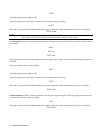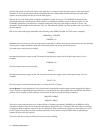Operating Instructions
62
Note that bits can be set in the fault register only when there is a change in either the status register or the mask register.
Therefore, if a bit is set in the mask register (unmasked) after the corresponding condition becomes true in the status
register, the associated bit will also be set in the fault register.
Bits may be set in the mask register (conditions unmasked) in either of two ways. The UNMASK command may be
followed by mnemonics which specify which conditions are unmasked (enabled to set bits in the fault register), or the
UNMASK command may be followed by a decimal number that is the sum of the weights of the bits to be set. The
mnemonics and bit weights are the same as in Table 3-9. The mnemonic NONE or decimal number 0 will clear all bits in
the mask register.
Bits are set in the mask register with either of the following codes (ERR/128, OR/4, and CC/2 used as examples):
UNMASK CC, OR, ERR
or
UNMASK 134
Mnemonics may be sent in any order, and they must be separated by commas. Note that the mask register does not affect the
status register, it simply determines which bits in the status register can set bits in the fault register.
The mask register may be read by sending:
UNMASK?
and addressing the power supply to talk. The response from the power supply will be in this format (using 34 as an
example):
UNMASK 134
The fault register may be read by sending:
FAULT?
and addressing the power supply to talk. The response from the power supply will be in this format (using 134 as an
example):
FAULT 134
The fault register is cleared immediately after it is read by the FAULT? query.
Service Request. In some applications it may be desirable to interrupt the controller when a power supply fault condition
occurs. The power supply interrupts the controller by asserting the service request (SRQ) line on the GP-IB. The ability to
generate service requests for fault conditions can be turned on and off using the following commands:
SRQ OFF or SRQ 0
SRQ ON or SRQ 1
The service request function allows use of either polling or interrupt programming. With SRQ on, the SRQ line will be
asserted true whenever the FAU bit in the serial poll register changes from 0 to 1. Therefore, the mask register, in addition
to specifying which conditions set the FAU bit, also determines which conditions can generate service requests. Use of the
FAULT? query will tell the user which condition caused the service request (except for PON, which is indicated by a
separate bit in the serial poll register).
The state of the service request on/off function may be read by sending:


















